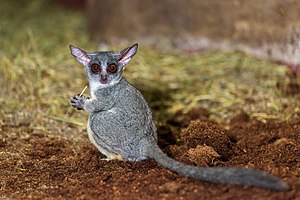Senegal Galago
| Senegal Galago | ||||||||||||
|---|---|---|---|---|---|---|---|---|---|---|---|---|

Senegal Galago ( Galago senegalensis ) |
||||||||||||
| Systematics | ||||||||||||
|
||||||||||||
| Scientific name | ||||||||||||
| Galago senegalensis | ||||||||||||
| É. Geoffroy , 1796 |
The Senegal Galago ( Galago senegalensis ), also called Northern or Steppe Galago , is a primate species from the Galagos family (Galagonidae).
features
Senegal Galagos are medium-sized Galagos, they reach a head body length of 13 to 21 centimeters and a tail length of 20 to 30 centimeters. Their weight is around 200 to 300 grams. Their fur is dense and woolly, it is colored gray-brown on the back, the belly side is white to light brown. The head is rounded, the eyes are very large as an adaptation to the nocturnal lifestyle. The hairless, independently movable ears are also large. The tail, which is longer than the body, is bushy at the end. The hind legs are strong, the tarsus is greatly elongated, on the second toes they have the cleaning claws typical of wet-nosed monkeys .
distribution and habitat
Senegal-Galagos are native to a large area in central Africa . Their distribution area extends from Senegal in the west to Sudan , Somalia and Ethiopia in the east and south to Kenya and Tanzania . Their habitat is rather dry, tree-lined areas such as savannahs, bush lands, but also mountain forests.
Way of life
These primates are nocturnal, during the day they sleep in the vegetation, in abandoned bird nests or in tree hollows. At night they go in search of food, climbing and jumping vertically and can bridge distances of up to 5 meters. While several animals often sleep cuddled together, they are always solitary looking for food. Their roaming areas are relatively large, they often urinate on their paws in order to mark their territory with fragrances.
food
The main food of the Senegal-Galagos is insects , to a small extent they also eat small vertebrates, eggs and flowers. Tree saps play an important role in the dry season.
Reproduction
The territory of one male overlaps with that of several females, during the mating season there are disputes between the males over access to the mating partners. The females can give birth twice a year; this high reproduction rate should be an adaptation to the harsh environmental conditions. At birth, the females build a leaf nest in which the young spend their first weeks of life. The gestation period is around 110 to 140 days, the litter size one to three (usually two). In the first few weeks, the mother carries the young around in their mouths or they cling to their fur. The boys are weaned after around three months and sexual maturity occurs around nine months. In human care, the animals can reach an age of up to 18 years.
Danger
Senegal-Galagos are widespread and relatively adaptable, with no major threats known at the moment. The IUCN lists the species as "not endangered" ( least concern ).
In Germany, Senegal Galagos (also called "Bushbaby") can be seen in Augsburg, Berlin, Bremen, Frankfurt and Rostock.
Systematics
The Senegal-Galago forms together with the Moholi-Galago and the Somalia-Galago the senegalensis species group within the genus of the Common Galagos . Four subspecies can be distinguished: the nominate form Galago senegalensis senegalensis from Senegal to Sudan, G. s. dunni in Somalia and Ethiopia, G. s. braccatus in Kenya and Tanzania and G. s. sotikae in Tanzania. Little is known about the boundaries between the individual subspecies.
literature
- Thomas Geissmann : Comparative Primatology. Springer-Verlag, Berlin a. a. 2002, ISBN 3-540-43645-6 .
- Ronald M. Nowak: Walker's Mammals of the World. 6th edition. Johns Hopkins University Press, Baltimore MD 1999, ISBN 0-8018-5789-9 .
- Don E. Wilson, DeeAnn M. Reeder (Eds.): Mammal Species of the World. A taxonomic and geographic Reference. Johns Hopkins University Press, Baltimore MD 2005, ISBN 0-8018-8221-4 .
supporting documents
Web links
- Information at Animal Diversity Web
- Galago senegalensis in the endangered Red List species the IUCN 2008 Posted by: S. Bearder, TM Butynski and Y. De Jong, 2008. Accessed on 28 1st of 2009.


